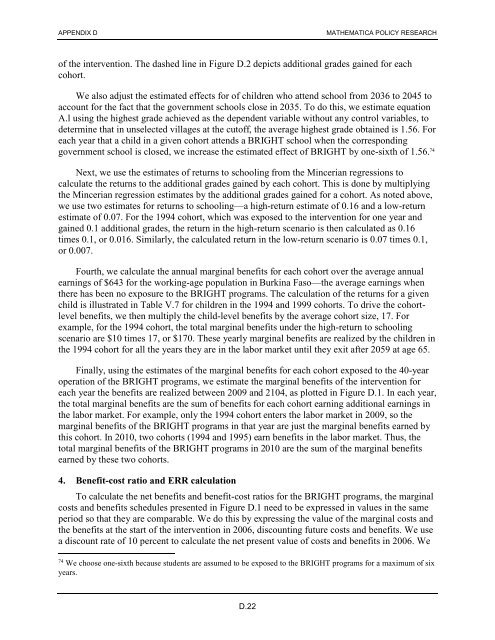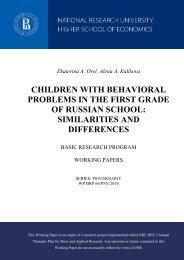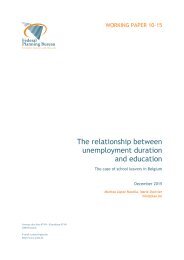Ten-Year Impacts of Burkina Faso’s BRIGHT Program
n?u=RePEc:mpr:mprres:2ecdd42bb503422b802ce20da2bf64b7&r=edu
n?u=RePEc:mpr:mprres:2ecdd42bb503422b802ce20da2bf64b7&r=edu
You also want an ePaper? Increase the reach of your titles
YUMPU automatically turns print PDFs into web optimized ePapers that Google loves.
APPENDIX D<br />
MATHEMATICA POLICY RESEARCH<br />
<strong>of</strong> the intervention. The dashed line in Figure D.2 depicts additional grades gained for each<br />
cohort.<br />
We also adjust the estimated effects for <strong>of</strong> children who attend school from 2036 to 2045 to<br />
account for the fact that the government schools close in 2035. To do this, we estimate equation<br />
A.l using the highest grade achieved as the dependent variable without any control variables, to<br />
determine that in unselected villages at the cut<strong>of</strong>f, the average highest grade obtained is 1.56. For<br />
each year that a child in a given cohort attends a <strong>BRIGHT</strong> school when the corresponding<br />
government school is closed, we increase the estimated effect <strong>of</strong> <strong>BRIGHT</strong> by one-sixth <strong>of</strong> 1.56. 74<br />
Next, we use the estimates <strong>of</strong> returns to schooling from the Mincerian regressions to<br />
calculate the returns to the additional grades gained by each cohort. This is done by multiplying<br />
the Mincerian regression estimates by the additional grades gained for a cohort. As noted above,<br />
we use two estimates for returns to schooling—a high-return estimate <strong>of</strong> 0.16 and a low-return<br />
estimate <strong>of</strong> 0.07. For the 1994 cohort, which was exposed to the intervention for one year and<br />
gained 0.1 additional grades, the return in the high-return scenario is then calculated as 0.16<br />
times 0.1, or 0.016. Similarly, the calculated return in the low-return scenario is 0.07 times 0.1,<br />
or 0.007.<br />
Fourth, we calculate the annual marginal benefits for each cohort over the average annual<br />
earnings <strong>of</strong> $643 for the working-age population in <strong>Burkina</strong> Faso—the average earnings when<br />
there has been no exposure to the <strong>BRIGHT</strong> programs. The calculation <strong>of</strong> the returns for a given<br />
child is illustrated in Table V.7 for children in the 1994 and 1999 cohorts. To drive the cohortlevel<br />
benefits, we then multiply the child-level benefits by the average cohort size, 17. For<br />
example, for the 1994 cohort, the total marginal benefits under the high-return to schooling<br />
scenario are $10 times 17, or $170. These yearly marginal benefits are realized by the children in<br />
the 1994 cohort for all the years they are in the labor market until they exit after 2059 at age 65.<br />
Finally, using the estimates <strong>of</strong> the marginal benefits for each cohort exposed to the 40-year<br />
operation <strong>of</strong> the <strong>BRIGHT</strong> programs, we estimate the marginal benefits <strong>of</strong> the intervention for<br />
each year the benefits are realized between 2009 and 2104, as plotted in Figure D.1. In each year,<br />
the total marginal benefits are the sum <strong>of</strong> benefits for each cohort earning additional earnings in<br />
the labor market. For example, only the 1994 cohort enters the labor market in 2009, so the<br />
marginal benefits <strong>of</strong> the <strong>BRIGHT</strong> programs in that year are just the marginal benefits earned by<br />
this cohort. In 2010, two cohorts (1994 and 1995) earn benefits in the labor market. Thus, the<br />
total marginal benefits <strong>of</strong> the <strong>BRIGHT</strong> programs in 2010 are the sum <strong>of</strong> the marginal benefits<br />
earned by these two cohorts.<br />
4. Benefit-cost ratio and ERR calculation<br />
To calculate the net benefits and benefit-cost ratios for the <strong>BRIGHT</strong> programs, the marginal<br />
costs and benefits schedules presented in Figure D.1 need to be expressed in values in the same<br />
period so that they are comparable. We do this by expressing the value <strong>of</strong> the marginal costs and<br />
the benefits at the start <strong>of</strong> the intervention in 2006, discounting future costs and benefits. We use<br />
a discount rate <strong>of</strong> 10 percent to calculate the net present value <strong>of</strong> costs and benefits in 2006. We<br />
74<br />
We choose one-sixth because students are assumed to be exposed to the <strong>BRIGHT</strong> programs for a maximum <strong>of</strong> six<br />
years.<br />
D.22







